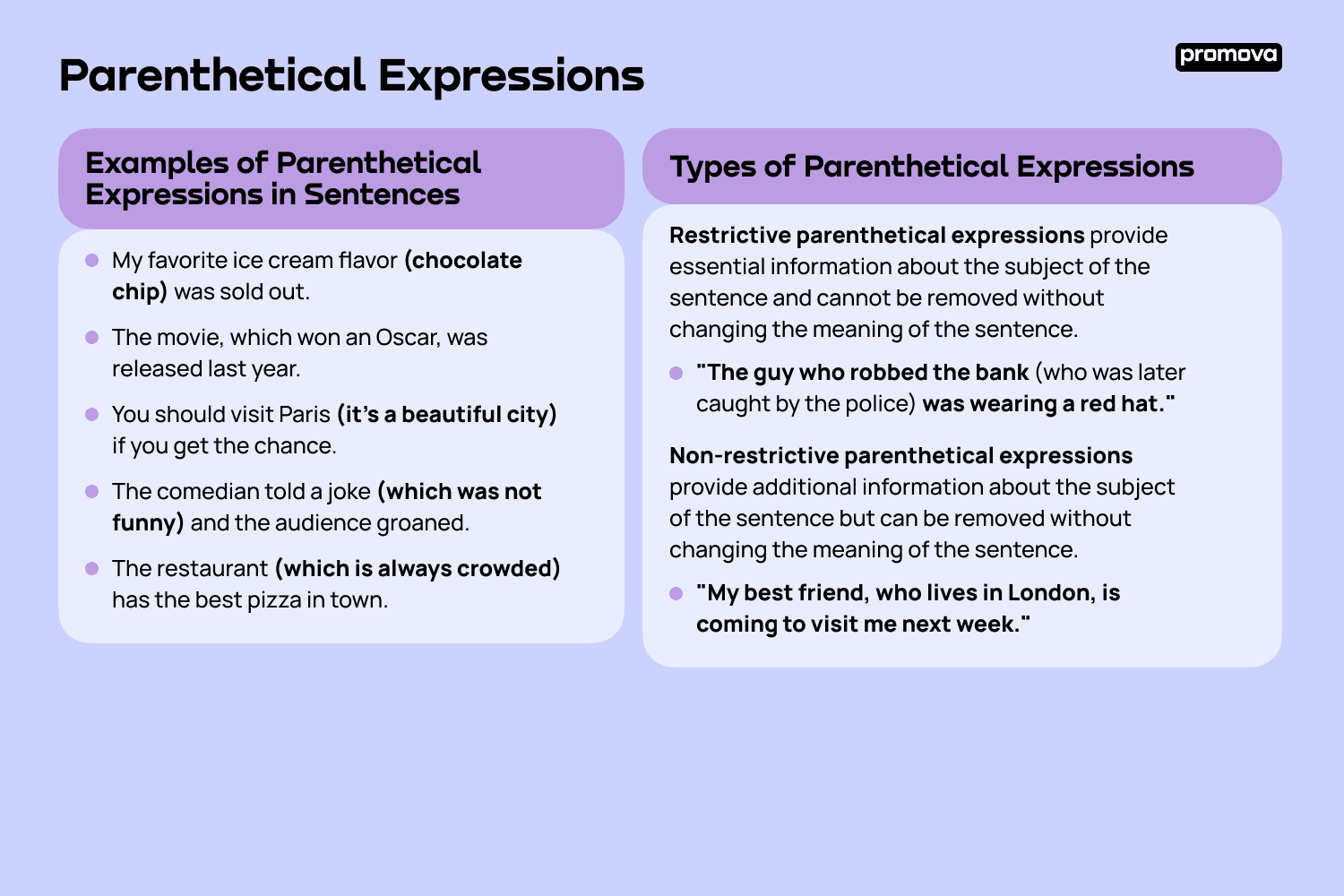Parenthetical Expressions
Contents
Parenthetical expressions are commonly used in English to provide additional information or clarification about a statement or sentence. In this reference, we will discuss the purpose of using parentheses, the different types of parenthetical expressions, and check out many examples.
Understanding the Purpose of Using Parentheses
The purpose of using parentheses in English is to provide information about a statement or sentence. They indicate that the information within the parentheses is not essential to the meaning of your sentence but rather an aside or an afterthought. This allows the writer to include important information without disrupting the flow of the sentence or paragraph.
Additionally, parentheses can be used to show that a word or phrase is being used in a different sense than it usually is.
What Are Parenthetical Expressions?
Parenthetical expressions are words, phrases, or clauses that are set off by parentheses and used to provide additional information or clarification about a statement or sentence.
They are not crucial to the meaning of the sentence but rather an afterthought or aside. Parenthetical expressions can be used to add information, clarify a point, or provide an example.
Types of Parenthetical Expressions
There are two main types of parenthetical expressions: restrictive and non-restrictive.
Restrictive parenthetical expressions provide essential information about the subject of the sentence and cannot be removed without changing the meaning of the sentence.
"The guy who robbed the bank (who was later caught by the police) was wearing a red hat."
Non-restrictive parenthetical expressions provide additional information about the subject of the sentence but can be removed without changing the meaning of the sentence.
“My best friend, who lives in London, is coming to visit me next week.”
Examples of Parenthetical Expressions in Sentences
Here are some examples of parenthetical expressions in sentences:
- My favorite ice cream flavor (chocolate chip) was sold out.
- The movie, which won an Oscar, was released last year.
- You should visit Paris (it's a beautiful city) if you get the chance.
- The comedian told a joke (which was not funny) and the audience groaned.
- The restaurant (which is always crowded) has the best pizza in town.

How to Use Parentheses Correctly
To use parentheses correctly, you must know when to use them and how to punctuate them. Here are some guidelines to follow:
- Use parentheses to set off non-essential information.
- Use commas to separate parenthetical expressions from the rest of the sentence.
- Use a period or a question mark outside the parentheses if the expression inside them is a complete sentence.
- Use a comma outside the parentheses if the expression inside the parentheses is an incomplete sentence.
Differences Between Parentheses and Other Punctuation Marks
Parentheses are often confused with other punctuation marks such as brackets, dashes, and commas. Here are some differences between parentheses and other punctuation marks:
- Brackets help enclose words or phrases that have been added to a sentence by someone other than the original author. Parentheses are used to enclose words or phrases that have been added by the original author.
- Dashes help indicate a sudden change in thought or tone. Parentheses are used to provide additional information or clarification.
- Commas help separate items in a list or to separate clauses in a sentence. Parentheses are used to provide additional information or clarification.
3
Summary
Parenthetical expressions are very common and you'll often find them in both casual speech and business writing. They are used to indicate that the information within the parentheses is not essential to the meaning of the sentence but rather an aside or an afterthought. With time, you'll quickly learn to use them in your own sentences without any problems!
Comments